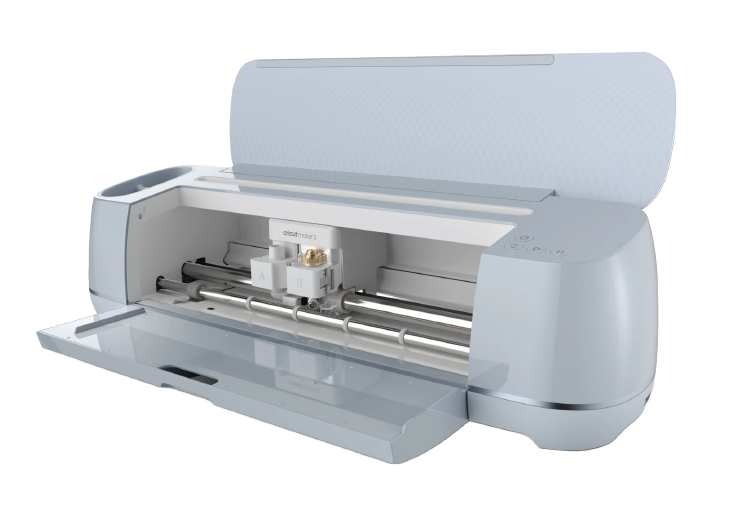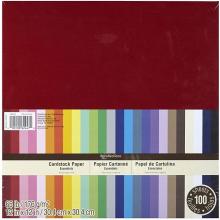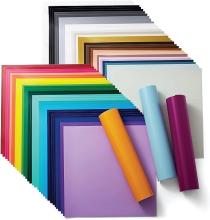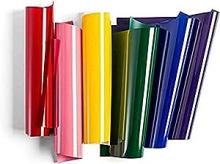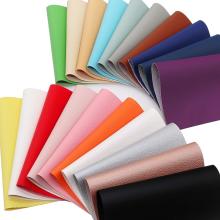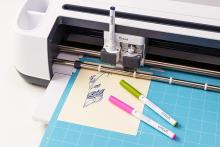Electronic Cutters
What is a Cricut Maker 3?
The Cricut Maker 3 is an electronic cutting machine that uses a small blade to slice through materials that you load into it with a special sticky mat. The machine can also produce drawings with Cricut brand markers and pens. Designs come from computer files that you can create from scratch using the Cricut Design Space software or download from craft websites and design marketplaces.
How do I use a Cricut Maker 3 in Studio 411?
Sessions are now available through the Studio 411 Equipment Reservation Site.
If you’re interested in learning more about operating a Cricut Maker 3, here are some helpful links:
- Cricut Maker 3 Overview (YouTube)
- Cricut Learn – The official Cricut learning portal.
- Michaels Online Class: Get to know the Cricut Maker 3 (YouTube)
Cricut FAQs
- A design prepared in Cricut Design Space.
- You will need to have a Cricut ID to work on files – it is free to sign up with an email address.
- You may use the Studio 411 Cricut Access account during your reservation, but any design time will count toward your machine usage time. Login credentials will be provided at the beginning of your reservation.
- Cricut Design Space offers a limited number of free fonts and designs.
- Design Space is compatible with the following formats: JPEG, PNG, SVG, DXF, EPS
- All materials for your project.
- This includes specialty supplies like transfer tape for adhesive vinyl projects and masking tape for heavy duty projects. A required and suggested materials list will be included in your reservation confirmation email.
The Maker 3 model is compatible with over 300+ materials. Please select Maker 3 on the following page to learn more:
Important Specifications
- The maximum material thickness is 2.4mm or approximately 3/32”.
- Most materials* must fit on a 12”x12” cutting mat to go through the machine.
- The maximum cutting mat area is 11.5”x11.5”.
*Cricut developed a Smart Materials line with a special backing that can be loaded straight into the machine without a cutting mat, allowing for projects with cut areas much longer than 11.5”.
- Smart materials are 13" wide with a maximum cut width of 11.7”.
- Each piece must be at least 6” long and 13” wide to properly run through the machine without a mat.
- Maximum length dimensions vary based on the material type.
- Limited roll holders available by request.
- Learn More About Smart Materials
Studio 411 does not supply any consumable materials.
Materials are available at many different stores including:
- Craft stores like Michaels, Jo-Ann, and Paper Source.
- (Some Cricut items are Michaels exclusives)
- Big box stores like Target and Walmart.
Materials are also available online:
- Some brands like Cricut or HTVront have webstores.
- Search Online marketplaces like Amazon and Etsy.
- Explore specialty sites like The 12x12 Cardstock Shop, 143VINYL, and Expressions Vinyl.
While many sites charge for designs, several craft blogs offer beautiful project files for personal use at no cost. If you're interested in free files, check out the following resource recommendations:
Design Marketplace Freebies
- Bearly Art Free SVGs
- Caluya Design
- CreativeFabrica
- DesignBundles.net
- Dreaming Tree
- Drizy Studio
- LoveSVG
- Printable Cuttable Creatables
- Simply Crafty SVGs
- SVGCuts
- TheHungryJPEG
Craft Blogs
- Abbi Kirsten Collections
- Amy Romeu
- Angie Holden - The Chic Country Cottage
- Avanti Morocha - Tutoriales de Cricut en Español (YouTube)
- Corinne Blackstone
- Craft with Sarah
- Designs By Miss Mandee
- Gina C. Creates
- Jennifer Maker
- Paper Glitter Glue
- Persia Lou
- Sweet Red Poppy
Free Fonts
Additional FAQs
You must use the laptop provided by Studio 411 Staff.
Yes, you need a Cricut ID to operate a Maker 3, but it's free to register for one with an email address on the Cricut website.
Please be sure to remember the email address and password that you used to register an account, as you will need them to log in to access your files when you show up for your appointment.
Cricut Design Space is available for Windows, Mac, iOS, and Android, but you will find the most up-to-date info about system requirements at the following page:
System Requirements - Design Space – Help Center (cricut.com)
Common Project Materials
Cardstock is a thick paper that is suitable for many crafts.
- 65 lb. cardstock is readily available at craft stores. Consider 80-110 lb. paper for sturdier projects and card bases.
- Can be patterned, textured, glittery, or have an adhesive backing.
- Specialty papers may require some setting adjustments to get the perfect cut.
- Typically sold in packs of 8.5”x11” or 12”x12” sheets but can be sold by the sheet.
For a cardstock project, all you have to bring is the paper.
- You are welcome to bring your own adhesive to stick things together while your other pieces are cutting – we will gladly put a silicone mat out for you to work on. If you need glue or tape recommendations, please email Studio411.
Tip: Make sure to write down the weight of your paper before you throw out your packaging!
Image credit: Amazon.com
Adhesive vinyl has a layer of glue that makes it stick to many different surfaces. It’s great for decals, business signage, room décor, and label making.
- Removable vinyl is intended for temporary applications – use this for stickers on expensive electronics or wall art in an apartment.
- Permanent vinyl is intended for long-term use. It’s designed to hold up better to wear and tear - think outdoor signs and glassware you’ll need to wash.
- Stencil vinyl has an adhesive that creates a stronger seal so your painting and etching projects will have cleaner edges.
- Comes with a protective paper backing that you stick to the cutting mat.
- All vinyl starts as a solid piece of material. You will have to weed your design before you can adhere it to something. Weeding is the process of removing the excess vinyl that surrounds your design after it’s been cut with the machine. It can be a very slow process to remove the pieces depending on the complexity of your project.
- Smaller cutouts and thin lines should be avoided. Tiny pieces can get stuck to the blade or get lost during the weeding process. Details with a thickness above 1/8” tend to cut better.
- Comes in many different colors and fun finishes including chalkboard, glitter, foil, and holographic.
- Typically available in rolls and 12"x12" sheets.
For a vinyl project, please bring the following:
- Vinyl
- Ask yourself if you need removable, permanent, or stencil vinyl for your project and be sure to always check your labels!
- Rolls must be cut down to fit on a 12”x12” mat unless it is a smart material. Paper trimmers are available.
- Transfer tape
- Optional: A blank surface to decorate.
- You can adhere your design to an object in the Studio or take it home sandwiched between your transfer tape and the paper backing.
Image credit: Amazon.com
Sometimes called "Iron-On" vinyl material, HTV requires a heat source to activate the adhesive that bonds it to certain fabrics and surfaces.
- We have multiple Cricut heat presses available that you can learn about here!
- It comes in many different colors and finishes but pay close attention to your labels and product descriptions.
- Each type is formulated to adhere to different surfaces or hold up to different types of wear. Some will stick better to cotton while others are intended for synthetic materials like polyester. Using the incorrect HTV could lead to scorched materials and damaged equipment.
- If you need help choosing materials, please email Studio411@helenplum.org.
- Typically, has built-in heat resistant transfer material that is shiny. The shiny side is what sticks to the cutting mat, so the blade will cut through the dull backside of your material.
- You will have to weed your material before you can adhere it to something – this could take a long time depending on the complexity of your design.
- Smaller details work better with HTV than adhesive vinyl, but they may come off in the wash much sooner.
- Your design needs to be reversed (mirrored) in Design Space so it will be facing the correct direction when you flip over the transfer sheet to bond it to a surface with heat.
- Typically, available in rolls and 12"x12" sheets.
For your heat transfer project, please bring the following:
- Heat Transfer Vinyl
- Remember to read your labels! Make sure you’re buying HTV or something marked as “iron-on.”
- Standard adhesive vinyl cannot be applied to fabric, and it is very dangerous to apply heat to it.
- Rolls must be cut down to fit on a 12”x12” mat unless it is a smart material. Paper trimmers are available.
- Heat Resistant Transfer Sheet (only if not built-in)
- Optional: The surface you intend to adhere your HTV to.
- Limited heat presses are available for use during your reservation.
- Access to additional machines will not extend your timeslot.
- Please mark the checkbox marked “I would like access to a heat press” in your reservation request form and staff will do their best to accommodate.
- Your project might require an extra reservation dedicated solely to heat pressing if you are trying to press more than one piece, so plan accordingly.
Reminder: Always cut your HTV shiny side down and mirror your design in Cricut Design Space!
Image credit: Amazon.com
The Cricut Maker 3 is compatible with many different types of fabric.
Common fabric projects include:
- Felt for rolled flowers
- Cotton for quilt appliques
- Faux leather for earrings and keychains
All fabric must be cut down to fit on a 12”x12” mat. Rotary cutters, rulers, and cutting mats can be used during a reservation, but you will not be granted extra time for material prep.
Image credit: Amazon.com
- Markers and pens must be Cricut brand to fit into the machine.
- Available in many weights and colors, including neons, pastels, and glitter.
- Calligraphy pens can be used to create text that looks almost hand drawn.
- Watercolor markers can be activated with water to add beautiful washes of color to a project.
Please note: At this time we are not able to allow infusible ink projects. Patron safety is our priority, and we are exploring options for proper ventilation.
Image credit: Amazon.com
- While Cricut offers an ever-growing range of materials, many other reputable craft brands make comparable and more affordable options. The benefit of buying Cricut material is that Cricut Design Space has presets that have optimized settings for its various product lines.
- Bring extra material! Making is an iterative process and mistakes are part of the learning process.
- Still not sure if your material is compatible with a Maker 3? Please Email Studio 411 for help.
